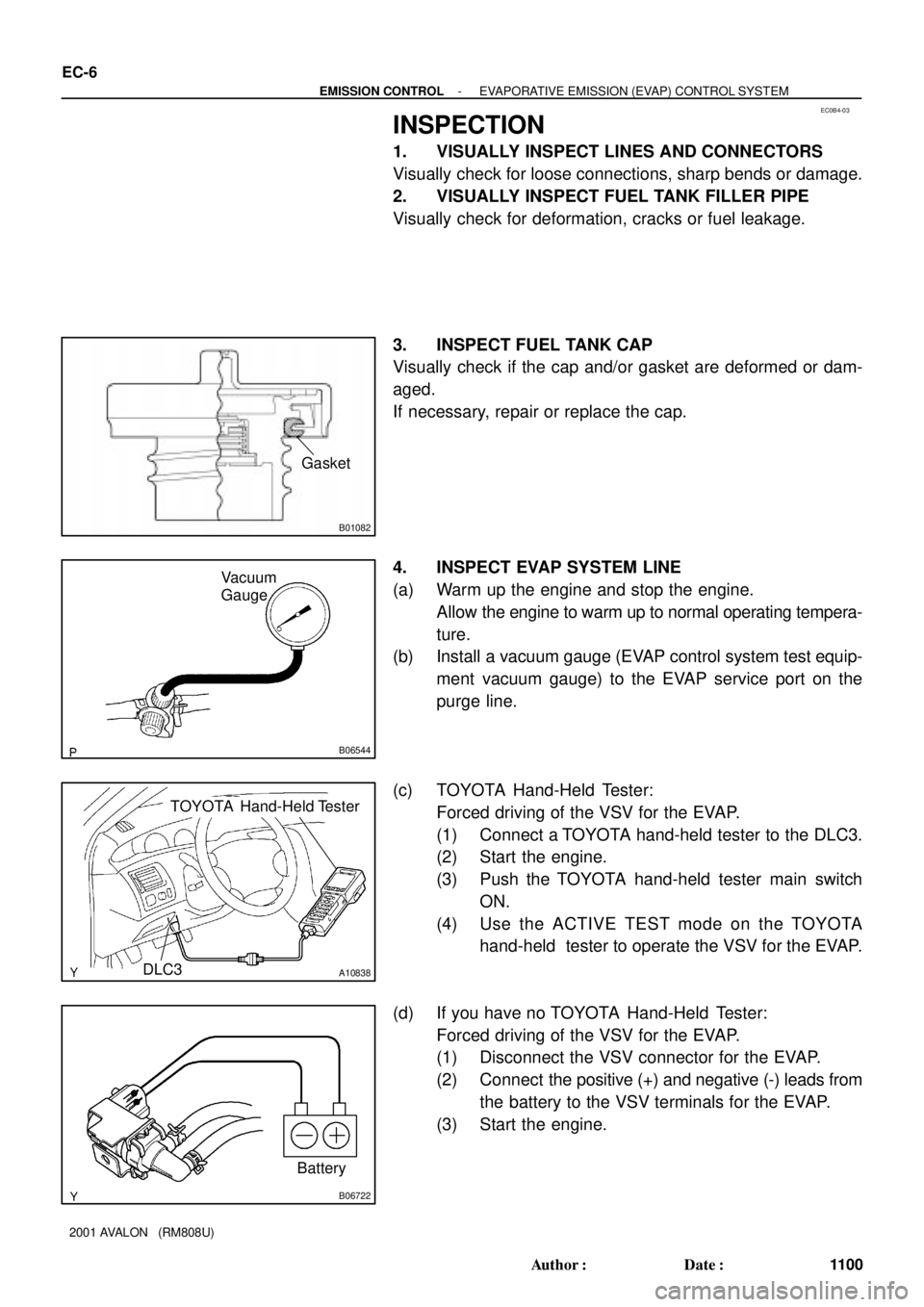Page 1210 of 1897
H03352H09519H09521H09522
Airbag
Sensor
Assembly Front Airbag
Sensor (LH)
(+) SL+
(-)SL-
Engine Room Main
Wire Harness
SL+
SL-
u "
DI-474
- DIAGNOSTICSSUPPLEMENTAL RESTRAINT SYSTEM
630 Author�: Date�:
2001 AVALON (RM808U)
11 Check engine room main wire harness.
PREPARATION:
(a) Disconnect the engine room main wire harness connector
on the airbag sensor assembly side.
(b) Using a service wire, connect SL+ and SL- of the connec-
tor (on the engine room main wire harness side) between
the engine room main wire harness and the front airbag
sensor (LH).
CHECK:
For the connector (on the engine room main wire harness side)
between the airbag sensor assembly and the engine room main
wire harness, measure the resistance between SL+ and SL-.
OK:
Resistance: Below 1 W
NG Repair or replace engine room main wire har-
ness.
OK
Repair or replace harness or connector between airbag sensor assembly and engine room main
wire harness.
Page 1243 of 1897
I00298
1 (+)
2 (-)
DI-548
- DIAGNOSTICSTHEFT DETERRENT SYSTEM
704 Author�: Date�:
2001 AVALON (RM808U)
INSPECTION PROCEDURE
1 Check engine hood courtesy switch.
PREPARATION:
(a) Remove engine hood lock assembly.
(b) Disconnect engine hood courtesy switch connector.
CHECK:
Check continuity between terminals 1 and 2 when engine hood
lock is locked and unlocked.
OK:
Engine hood lockTester connectionSpecified condition
LOCK-No continuity
UNLOCK1 - 2Continuity
NG Replace engine hood courtesy switch.
OK
2 Check harness and connector between theft deterrent ECU and switch, switch
and body ground (See page IN-30).
NG Repair or replace harness or connector.
OK
Check and replace theft deterrent ECU (See
page IN-30).
Page 1256 of 1897

DI01Q-10
THEFT DETERRENT SYSTEM Check Sheet
Inspector 's name:
Customer 's Name
Date of VehicleRegistration No.
Registration Year
Frame No.
Odometer Reading / /km
Mile
Weather Conditions
When Problem
Occurred Frequency Problem OccursWeather
Outdoor temperature
/ /
� Constant � Sometimes ( Times per day, month)
� Once only Brought in
� Theft deterrent system cannot be set.
� Indicator light does not flash when the theft deterrent system is set.
(It stays on or does not light at all.)
� Theft deterrent system
does not operate.� When unlocked using the
door lock knob.
� When the engine hood is
opened.
� System cannot be
canceled once set.� When door is unlocked using key or wireless door lock control system.
� When the key is inserted in the ignition key cylinder and turned to ACC or ON
position.
(However, only when the system has never operated)
� When the luggage compartment door is opened with the key.
� System cannot be
canceled during warning
operation.� When door is unlocked using key or wireless door lock control system.
� When the key is inserted in the ignition key cylinder and turned to ACC or ON
position.
� Warning operation starts when the system is set and the door or luggage compartment door is opened with
the key.
� Others.
Date Problem First Occurred
� Fine � Cloudy � Rainy � Snowy
� Various/Others
� Hot � Warm � Cool
� Cold (Approx. 5F ( 5C))
Problem Symptom
Malfunction
� Horns only
� Theft deterrent horn only
� Headlights only
� Taillights only
� Starter cut only
� Door lock operation only
DI-518
- DIAGNOSTICSTHEFT DETERRENT SYSTEM
674 Author�: Date�:
2001 AVALON (RM808U)
CUSTOMER PROBLEM ANALYSIS CHECK
Page 1259 of 1897

DI4DL-03
- DIAGNOSTICSTHEFT DETERRENT SYSTEM
DI-519
675 Author�: Date�:
2001 AVALON (RM808U)
PRE-CHECK
1. THEFT DETERRENT SYSTEM
When the system is set to the theft deterrent mode and any of
the following conditions are met, the system sounds the horns
and flashes the headlights and the taillights for approx. 1 min-
ute.
At the same time the system locks all doors (If all door are not
locked at once, the system repeats door locking operation ev-
ery 6.38 seconds during the one minute alarm time).
There are 2 modes in this system, which are active mode and
passive mode.
All initial setting are performed in active mode. It can be
switched to passive mode by specified operation. (See step 4.
CHANGING METHOD OF PASSIVE MODE)
Condition:
�Any of the doors (Including the engine hood and luggage
compartment door) is unlocked or opened without the
key. *1
�The battery terminal is disconnected and reconnected.
�The system receives panic signal from remote keyless
entry. *2
*1: Only active arming mode.
*2: When the ignition key is not inserted in the key cylinder.
There are 4 conditions in this system which are disarming
condition, disarming preparation condition, arming condition
and alarming condition.
(a) Disarming condition:
(1) When a user is near the vehicle.
(2) When the alarming function does not operate.
(3) When theft deterrent function is not performed.
(b) Disarming preparation condition:
(1) Time from a user locks a door to be leaves the ve-
hicle.
(2) Time until transferring to disarming condition.
(3) Theft deterrent function is not performed.
(c) Arming condition:
(1) When a user leaves the vehicle completely.
(2) When theft deterrent function is possible.
Page 1273 of 1897

EC0B4-03
B01082
Gasket
B06544
Vacuum
Gauge
A10838
TOYOTA Hand-Held Tester
DLC3
B06722
Battery EC-6
- EMISSION CONTROLEVAPORATIVE EMISSION (EVAP) CONTROL SYSTEM
1100 Author�: Date�:
2001 AVALON (RM808U)
INSPECTION
1. VISUALLY INSPECT LINES AND CONNECTORS
Visually check for loose connections, sharp bends or damage.
2. VISUALLY INSPECT FUEL TANK FILLER PIPE
Visually check for deformation, cracks or fuel leakage.
3. INSPECT FUEL TANK CAP
Visually check if the cap and/or gasket are deformed or dam-
aged.
If necessary, repair or replace the cap.
4. INSPECT EVAP SYSTEM LINE
(a) Warm up the engine and stop the engine.
Allow the engine to warm up to normal operating tempera-
ture.
(b) Install a vacuum gauge (EVAP control system test equip-
ment vacuum gauge) to the EVAP service port on the
purge line.
(c) TOYOTA Hand-Held Tester:
Forced driving of the VSV for the EVAP.
(1) Connect a TOYOTA hand-held tester to the DLC3.
(2) Start the engine.
(3) Push the TOYOTA hand-held tester main switch
ON.
(4) Use the ACTIVE TEST mode on the TOYOTA
hand-held tester to operate the VSV for the EVAP.
(d) If you have no TOYOTA Hand-Held Tester:
Forced driving of the VSV for the EVAP.
(1) Disconnect the VSV connector for the EVAP.
(2) Connect the positive (+) and negative (-) leads from
the battery to the VSV terminals for the EVAP.
(3) Start the engine.
Page 1274 of 1897

B06545
B08626
Hose Clipper
Air Drain Hose
B06546
Pressure
Gauge
Pressure
- EMISSION CONTROLEVAPORATIVE EMISSION (EVAP) CONTROL SYSTEM
EC-7
1101 Author�: Date�:
2001 AVALON (RM808U)
(e) Check the vacuum at idle.
Vacuum:
Maintain at 0.368 - 19.713 in.Hg (5 - 268 in.Aq) for over
5 seconds
HINT:
If the vacuum does not change, you can conclude that the hose
connecting the VSV to the service port has come loose or is
blocked, or the VSV is malfunctioning.
(f) TOYOTA Hand-Held Tester:
Conclude forced driving of the VSV for the EVAP.
(1) Stop the engine.
(2) Disconnect the TOYOTA hand-held tester from the
DLC3.
(g) If you have no TOYOTA Hand-Held Tester:
Conclude forced driving of the VSV for the EVAP.
(1) Stop the engine.
(2) Disconnect the positive (+) and negative (-) leads
from the battery from the VSV terminals for the
EVAP.
(3) Connect the VSV connector for the EVAP.
(h) Disconnect the vacuum gauge from the EVAP service
port on the purge line.
(i) Connect a pressure gauge to the EVAP service port on
the purge line.
(j) Check the pressure.
(1) Close off the air drain hose at the marked position
of the canister with a hose clipper or similar instru-
ment.
(2) Add the pressure (13.5 - 15.5 in.Aq) from the EVAP
service port.
Pressure:
2 minutes after the pressure is added, the gauge
should be over 7.7 - 8.8 in.Aq.
HINT:
If you can't add pressure, you can conclude that the hose con-
necting the VSV�canister�fuel tank has slipped off or the
VSV is open.
Page 1286 of 1897
EM0CB-03
A10537
CO/HC Meter
- ENGINE MECHANICALCO/HC
EM-1
985 Author�: Date�:
2001 AVALON (RM808U)
CO/HC
INSPECTION
HINT:
This check is used only to determine whether or not the idle CO/
HC complies with regulations.
1. INITIAL CONDITIONS
(a) Engine at normal operating temperature
(b) Air cleaner installed
(c) All pipes and hoses of air induction system connected
(d) All accessories switched OFF
(e) All vacuum lines properly connected
(f) SFI system wiring connectors fully plugged
(g) Ignition timing check correctly
(h) Transmission in neutral position
(i) Tachometer and CO/HC meter calibrated by hand
2. START ENGINE
3. RACE ENGINE AT 2,500 RPM FOR APPROX. 180 SE-
CONDS
4. INSERT CO/HC METER TESTING PROBE AT LEAST
40 cm (1.3 ft) INTO TAILPIPE DURING IDLING
5. IMMEDIATELY CHECK CO/HC CONCENTRATION AT
IDLE AND/OR 2,500 RPM
HINT:
When doing the 2 mode (2,500 rpm and idle) test, follow the
measurement order prescribed by the applicable local regula-
tions.
Page 1288 of 1897

EM0CC-03
P19471Compression Gauge
- ENGINE MECHANICALCOMPRESSION
EM-3
987 Author�: Date�:
2001 AVALON (RM808U)
COMPRESSION
INSPECTION
HINT:
If there is lack of power, excessive oil consumption or poor fuel
economy, measure the compression pressure.
1. WARM UP AND STOP ENGINE
Allow the engine to warm up to normal operating temperature.
2. REMOVE IGNITION COILS (See page IG-5)
3. REMOVE SPARK PLUGS
Using a 16 mm plug wrench, remove the 6 spark plugs.
4. CHECK CYLINDER COMPRESSION PRESSURE
(a) Insert a compression gauge into the spark plug hole.
(b) Fully open the throttle.
(c) While cranking the engine, measure the compression
pressure.
HINT:
Always use a fully charged battery to obtain engine speed of
250 rpm or more.
(d) Repeat steps (a) through (c) for each cylinder.
NOTICE:
This measurement must be done in as short a time as pos-
sible.
Compression pressure:
1,500 kPa (15.3 kgf/cm
2, 218 psi)
Minimum pressure:
1,000 kPa (10.2 kgf/cm
2, 145 psi)
Difference between each cylinder:
100 kPa (1.0 kgf/cm
2, 15 psi) or less
(e) If the cylinder compression in 1 or more cylinders is low,
pour a small amount of engine oil into the cylinder through
the spark plug hole and repeat steps (a) through (c) for
cylinders with low compression.
�If adding oil helps the compression, it is likely that
the piston rings and/or cylinder bore are worn or
damaged.
�If pressure stays low, a valve may be sticking or
seating is improper, or there may be leakage past
the gasket.
5. REINSTALL SPARK PLUGS
6. INSTALL IGNITION COILS (See page IG-5)